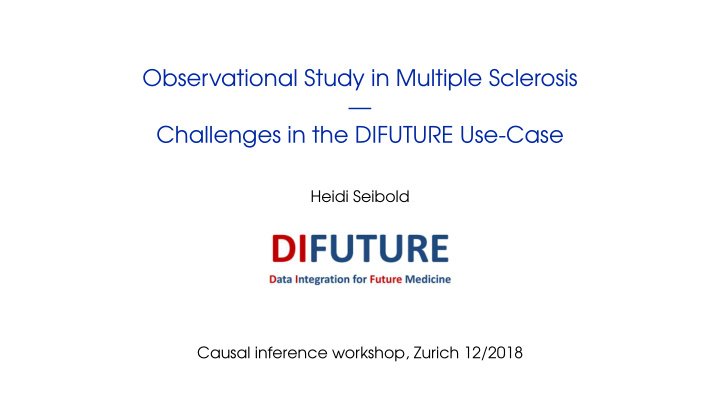



Observational Study in Multiple Sclerosis — Challenges in the DIFUTURE Use-Case Heidi Seibold Causal inference workshop, Zurich 12/2018
MS Use-Case DIFUTURE Heidi Seibold 2/ 17
MS Use-Case DIFUTURE Heidi Seibold Notation and Definitions MS Multiple sclerosis cMRT Cerebral magnetic resonance tomography (images of the brain) sMRT Spinal magnetic resonance tomography (images of the spine) t i Month i after first relevant cMRT (= cMRT before treatment start) 3/ 17
MS Use-Case DIFUTURE Heidi Seibold Develop a model which can be used for making individual treatment decisions in patients with MS • Treatment success if no new or enlarged lesions visible in sMRT and cMRT between months 6 ( t 6 ) and 24 ( t 24 ) • 3 treatment options : ◮ No treatment ◮ Basic treatment ◮ Strong treatment • A variety of patient characteristics can potentially influence treatment success 4/ 17
MS Use-Case DIFUTURE Heidi Seibold Data Data collected as part of clinical routine at MRI (TU Munich). Outcome Treatment Baseline patient characteristics 5/ 17
MS Use-Case DIFUTURE Heidi Seibold Data Outcome: New or enlarged lesions visible in sMRT and cMRT between t 6 and t 24 (yes/no) • No sMRT • cMRT “usually” around t 0 , t 12 and t 24 (not as needed t 0 , t 6 and t 24 ). 6/ 17
MS Use-Case DIFUTURE Heidi Seibold Data 1 Treatment Patient 2 Basic Strong 3 Untreated 4 0 6 12 24 Time in months 7/ 17
MS Use-Case DIFUTURE Heidi Seibold Data 1 Treatment Basic Strong Patient 2 Untreated 3 cMRI 4 0 6 12 24 Time in months Treatment: • If no treatment within the first 2 years after diagnosis: treatment = no treatment • Otherwise: treatment = first treatment given • Treatment switches are possible 8/ 17
MS Use-Case DIFUTURE Heidi Seibold Data 1 Treatment Basic Strong Patient 2 Untreated 3 cMRI 4 0 6 12 24 Time in months 9/ 17
MS Use-Case DIFUTURE Heidi Seibold Data Baseline patient characteristics: • Many possible characteristics available • Many missing values (potentially not missing at random) • Data quality potentially low 10/ 17
Challenges
MS Use-Case DIFUTURE Heidi Seibold How to deal with the issue of censoring in the outcome? • We are interested in new or enlarged lesions between t 6 and t 24 • MRTs are mostly not done at these time points • Can we use imputation methods? • Can we use methods that can deal with censoring? 12/ 17
MS Use-Case DIFUTURE Heidi Seibold How to deal with the fact that for most patients we have only one sMRT? • Clinician say that we can assume that there is no spinal progression if no sMRT was conducted. • Is there a way to account for the insecurity? 13/ 17
MS Use-Case DIFUTURE Heidi Seibold How to obtain causal treatment effects? • Data is observational • We want to be able to say why a patient should receive which treatment 14/ 17
MS Use-Case DIFUTURE Heidi Seibold What to do in case of treatment switches? • Patients sometimes switch from one treatment to another during the study period • Is there a way to account for this? • Would it be ok to ignore treatment switches? If so, why? 15/ 17
MS Use-Case DIFUTURE Heidi Seibold What to do with missing values in patient characteristics? 16/ 17
MS Use-Case DIFUTURE Heidi Seibold What to do with other data issues? • Treatment starts before first cMRT • What to do if data quality in certain patient characteristics is bad? • ... 17/ 17
Recommend
More recommend